| The Selection of Clausula Sources for ThirteenthCentury Motets:
Some Practical Considerations and Aesthetic Implications
2 |
| 音楽エッセイのページへ戻る | 初期多声音楽 | St.マーシャル楽派へ |
| Leoninのページへ | ノートルダム楽派(conductus)のページへ |
ペロタン(Viderunt Omnes) |
| ペロタン(Alleluja Nativitas) | ペロタン Clausulaのページ | まうかめ堂さんのページへ |
| substitute clausulaのページへ | 中世音楽のページへ | 前のページへ |
| 次のページへ |
| It is also striking that composers avoided
converting third-mode clausulae into motets. Almost 20% of the clausulae
in the control group are in the third rhythmic mode compared to less than
15% of those in the motet group. While clausulae with high levels of modal
purity were avoided throughout the motet group, the rhythmic pattern of
mode 3 would have presented special problems for composers of early Latin
motets, who generally underlaid texts to preexisting clausulae in such a
manner as to have poetic accents coincide with musical ones.l6 Since the rhythmic pattern of mode 3 begins with two accented notes, it requires the text underlay of two adjacent accented syllables. The composer of Ad veniam per veniam (635) came up with an ingenious solution: as shown below in example 6, he started most lines of text with either a one- or a four-syllable word, which allows for correct text declamation in the third mode.l7 作曲者が第3モードのクラウズラをモテットへ転換することを避けていたことは、注目すべきことである。コントロールグループのクラウズラのおよそ20%は、モテットグループのそれの15%未満と比較して、第3モードにある。モード純度の高いクラウズラがモテットグループを通して避けられていた間、第3モードのリズムパターンは初期ラテン語モテットの作曲者(詩のアクセントと音楽のそれを一致させるやり方で予め存在しているクラウズラを歌詞化した)にとっては特別な問題を提起した。 第3モードのリズムパターンは2か所にアクセントがある記譜( 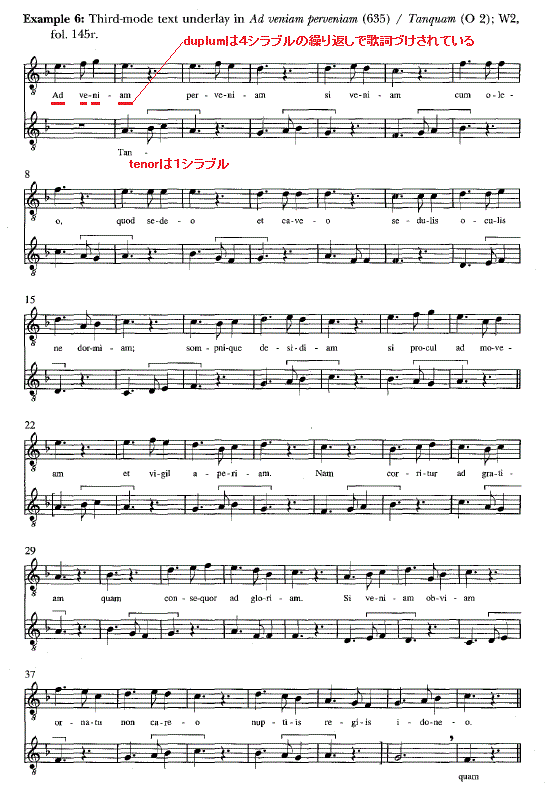 ①Having focused on the rhythmic articulation of individual beats, I will now consider overall phrase organization in the duplum voice, and its effect on text structure. As with modal purity, significant differences between the source and control groups with respect to phrase organization support the hypothesis that composers were aware of stylistic attributes suitable for texting and chose their source clausulae accordingly. ②As summarized in table 4, clausulae that were converted into motets are generally longer (as measured in ternary-long units) and have more phrases than clausulae that did not become motets. In addition, those clausulae in the control group that have regular phrasing (defined as clausulae in which more than eighty percent of their dupla phrases are the same length) are more than double the number of those in the motet group. Presumably, the combination of regular line lengths and consistent rhythmic patterning would support extremely regular poetry in terms of line lengths and text declamation. ③Therefore it seems significant that whereas only one motet source combines regular phrasing with a high level of modal purity, nearly half of the control clausulae feature such a combination.18 This suggests that motet composers not only wanted a meaningful number of phrases with which to work, but also that they were more interested in contrast and irregularities of design than in writing regular poetry. If the latter were the case and a "conductus-like" text with uniform line lengths was considered ideal, why did composers overlook so many clausulae with regular phrasing as sources? They seem to have perceived their new genre as something different from the conductus. ①個々のビートのリズムarticulationに焦点を当ててみて、私は今、duplumにおけるフレーズ構成と歌詞構造への影響を考えてみる。モード純度として、フレーズ構造に関するソースとコントロールグループの間の重要な違いが、作曲者は歌詞づけに適した様式属性を認識しそれに応じてソースとなるクラウズラを選ぶという仮説を支持することである。 ②table4でまとめられているように、モテットに転換されたクラウズラは一般的により長く、そしてモテットにならなかったクラウズラ群よりも多くのフレーズを持っている。 さらに、規則正しいフレーズを持つコントロールグループのクラウズラ群(80%以上の長さが同じ長さと定義される)は、モテットグループの2倍なのである。おそらくは、規則的な行の長さと一貫したリズムパターンの組み合わせは、行の長さと歌詞のデクラマシオンの面において、極端に規則的な詩であることを支持することであろう。 ③それゆえに、一方で一つのモテットソースだけが規則的なフレーズと高いレベルのモード純度とを組みあわせ、コントロールグループのクラウズラのほとんど半分しかそうした組み合わせを特徴としない、ということは非常に重要に思える18。これは、モテット作曲家が意味のあるフレーズの数を求めていただけでなく、彼らが規則的な詩を書くよりも対照的かつ不規則なデザインに興味を持っていた、ということを示している。後者の場合、そして統一された長さの行を持つconductusのような歌詞が理想として考えられていたならば、なぜ作曲者たちはソースとしての規則的なフレーズを持つ多くのクラウズラを見逃したのだろうか?彼らは新しいジャンルを、conductusとは別の何かに見出そうとしたのである。 18. The clausula source for Deus omnium (444) has a first-mode duplum with a modal purity level of 83.3%; the duplum is also organized into completely regular six-beat phrases.Clausulae in the control group that combine regular modal rhythm and regular phrasing include nos. 30, 48, 87, 99, 138, 175, 189, and 241. The vast majority of these clausulae have third-mode dupla.  The manner in which a motet text is communicated is also affected by the nature of phrase endings in the clausula model. Example 7 illustrates six cadential patterns found in the selected repertory. The full cadence features simultaneous closure in both voices (exx. 7a.1-7a.3). Occasionally, these cadences are extended by the use of a plica or longa florata in the duplum that requires transcription of the following tractus as a breath mark (exx. 7b.1-7b.2). In effect, this weakens the sense of closure by providing for musical continuity between phrases. The half, implied, and "feminine" cadences are only found in clausulae that mix ternary-long with either long or breve rests. In the half cadence (ex. 7c), the last pitch in the duplum confirms the consonance initially established by the tenor and duplum, whereas in an implied cadence (ex. 7d), the final sonority suggested by the last pitch in the duplum contradicts that of the initial tenor-duplum consonance. The "feminine" cadence repeats the cadential pitch in the duplum, in a manner analogous to a feminine poetic ending (ex. 7e). In the sixth cadence type, the tenor continues beneath a phrase break in the duplum, resulting in overlap between the voices (ex. 7f). モテットの歌詞が伝えられた方法は、クラウズラモデルの最後のフレーズの性質によって影響される。Example 7は、選択されたレパートリーのうちでみられた6つのカデンツパターンを示している。フルカデンツは2声が同時に終止することになる。ときに、こうしたカデンツは、exx. 7b.1-7b.2でみられるduplumにおけるplicaやlonga florataの使用によって拡大される。結果として、フレーズ間の音楽の持続性を供給することによって終止の感覚が弱まることになる。ハーフカデンツであるfeminineカデンツはlongとbreveの休符とternary-longとが混合したクラウズラにおいてのみ見出される。ex. 7cで示されたハーフカデンツにおいて、duplumの最後の音はtenorとduplumによって最初に作られた協和音程を確認する。一方、ex. 7dで見られる隠れたカデンツにおいては、duplumの最後の音によって示された最後の音程は、最初のtenor-duplumの協和音程とは正反対になる(訳注;この例では短7度になっている)。ex. 7eで示される”feminine"終止は、女性詩の終止の例に倣い、duplumにおける最後の音が繰り返される。6番目のカデンツにおいては、tenorはduplumの下方であり続け、結果として、声部間がオーバーラップすることになる。 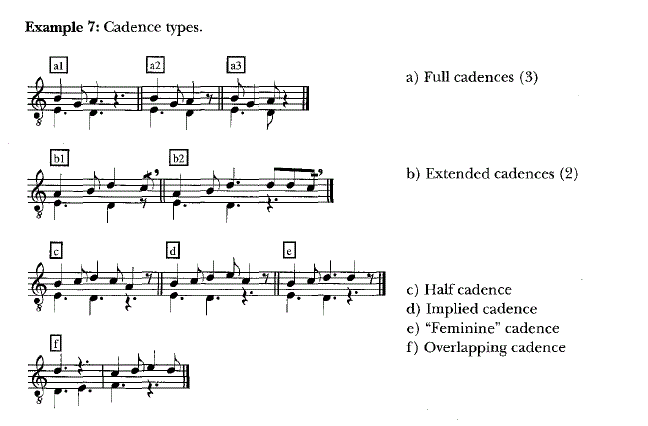 ①As summarized in table 5, the motet group has an average of three different cadence types per clausula; nearly all of its members have multiple cadence types per clausula and 34.5% of the motet sources feature more than three different cadence types. ②In contrast, one-third of the clausulae in the control group have only one cadence type. This condition is especially common in clausulae with tenors moving in unpatterned ternary or duplex longs, and may explain why composers avoided converting clausulae with unpatterned tenors into motets. ③The control pool also includes several clausulae that would have been especially problematic to convert into motets; two clausulae have dupla made up of one continuous phrase (nos. 15 and 176), and six have constantly overlapping cadences until the end (nos. 10, 17,27,57, 175, and 228). ①table5でまとめられているように、モテットグループはひとつのクラウズラあたり平均して、3つの異なったタイプのカデンツを保持している。ほとんどすべてがいくつかのカデンツのタイプを有しており、そして、モテット源の34.5%が三つ以上の異なったカデンツタイプを特徴としている。 ②対照的に、コントロールグループのクラウズラ群の約1/3はひとつのカデンツタイプだけを有している。この状態はことに、パターン化していないternaryやduplex longで動くtenorを有しているクラウズラ群において一般的である。そしてそれはなぜ作曲者たちがパターン化していないtenorを持ったクラウズラをモテットへ転換することを避けたのかを示す理由となるかもしれない。 ③コントロールプールは、モテットに転換したことに疑問があったであろういくつかのクラウズラ群を含む。ふたつのクラウズラは、持続するフレーズから作られるduplumを持っている(nos. 15 and 176)。そして6つのクラウズラは最後まで常に重複するカデンツがある。  ①If cadences are the musical equivalent of punctuation, then from the standpoint of texting, it would be logical that the motet group would favor a greater variety of types. 19 This situation allows for various degrees of closure on a continuum that ranges from the strongest, or full cadence, to the weakest, or overlapping, type. ②In effect, a variety of phrase endings offers the possibility of grouping lines of text into larger syntactic or semantic units that are set off by full cadences. As I have shown elsewhere (Kidwell 1993) and will illustrate in example 9, early motet composers regularly availed themselves of such opportunities to segment their texts. Conversely, the two extreme approaches found in the control group would have been unsuitable for texting: a clausula without cadences fails to convey any sense of punctuation whereas a clausula with only one cadence type lacks the hierarchical means to differentiate strength of closure and therefore to group lines into larger semantic units. ①もしもカデンツが音楽的な句読点に相当するのであれば、歌詞づけの観点から、モテットグループがさまざまな種類のものを好むであろうことは論理的である。こうした状況は、最強あるいはフルカデンツから最弱あるいは重複タイプに対してまで広がる連続におけるさまざまな終止の程度を示している。 ②実際、フレーズの終わりの多様性は、フルカデンツから始まるより大きな構文上、意味論上の単位への歌詞の行の分類の可能性を差し示す。example 9で示されたように、初期のモテット作曲者は、規則的に歌詞を分割する機会を得た。逆に、コントロールグループにおいて見出される二つの極端なアプローチは、歌詞づけには不適当である。カデンツを持たないクラウズラは、句読点感覚を伝えることには失敗している。一方において、一つしかカデンツを持っていないクラウズラは、終止の強さを区別する階層的手段を欠いている。そしてそれゆえ、より大きな意味論単位へと行をグループ化する。 A good clausula source, then, is one that provides the motet creator with one or more means to differentiate units of text: contrasting patterns of declamation, varied phrase lengths, or a hierarchy of cadential patterns. A close examination of two complete clausulae will demonstrate how the various stylistic elements interact and will further illustrate stylistic differences between the control and motet groups. よいクラウズラソースとは、歌詞単位を区別するための一つあるいはそれ以上手段をモテット作者に供給するものである。デクラマシオンの対照的なパターン、変化するフレーズの長さ、あるいはカデンツパターンの階層等である。二つの完全なクラウズラの綿密な研究は、さまざまな様式要素がどのように交叉するであろうかを証明し、そしてコントロールグループとモテットグループの間の様式的差異を説明することであろう。 ①Clausula no. 99, representative of the control group, appears below as example 8. This setting of Latus est from the Easter Alleluia Pascha nostrum (M 14) combines a first-mode duplum with a fifth-mode tenor. Its overall length of seventy-four ternary-long beats could have provided a composer with enough material to support a meaningful added text. However, it has other attributes that are atypical of motet sources. It has a modal purity level of 83.1 %, which exceeds the norms for both the motet and control groups. <コントロールグループの代表例> ②The phrase organization of this Latus est clausula is also quite regular: it has eight phrases of eight ternary-long beats before a phrase of ten beats leading to an organal conclusion (example 8 omits this organal ending because motet composers typically stopped texting just before such concluding flourishes). It should also be noted that the tenor and duplum cadence together with a full (or masculine) ending for all nine phrases. ①コントロールグループを代表しているクラウズラno.99はexample 8に示されている。この Easter Alleluia Pascha nostrumからのLatus est セッティングは、duplumの第1モードとtenorの第5モードのコンビである。その74のternary-longビートの全体の長さは、作曲者に、意味ある付加された歌詞の十分な材料を提供する。しかしながら、それはモテット源としては不適格である。そのモード純度は83.1%である。モテットグループ、コントロールグループの基準を上回っている。 ②このLatus estクラウズラのフレーズ構造は、まったく規則的である。それは、オルガヌムの結末を導く10ビートのフレーズの前に8つのternary-longの8つのフレーズを持っている。tenorとduplumのカデンツはすべて9番目のフレーズでフルエンディングであることに注意したい。 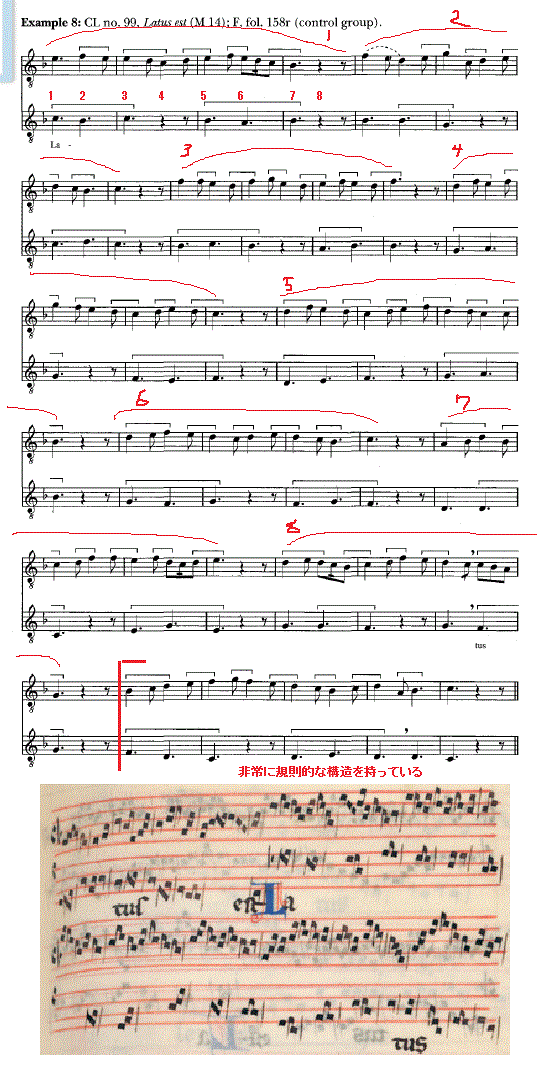 ①This composition may well have been considered a good clausula in its time. In fact, its regularity and periodicity may reflect the influence of Perotinian style, and Perotin was regarded by Anonymous IV as the best composer of discant (Yudkin 1985: 39). ②A texted version of this model could have featured regular declamation of thirteen-syllable lines as prefigured by modal purity and uniform phrase lengths, in which case the resulting motet could have approximated a conductus. Yet while many attributes found in this Latus est clausula typify the control group, few thirteenth-century motets exhibit such regularity. ①この作品は、その当時としては、よいクラウズラであったと考えられる。その規則性、そして周期性はペロタン風スタイルを踏襲している。そして、ペロタンはAnonymous IVによって、「ディスカントの最良の作曲者」と見なされていた。 ②このモデルの歌詞つきバージョンは、モーダル純度と統一されたフレーズの長さによって予め決められた13のシラブル行の規則的なデクラマシオンとして特徴づけられたことであろう。そしてこのケースにおいては、結果としてできるモテットはconductusに近いようなものとなったことであろう。このLatus estクラウズラに見られる多くの性質は、コントロールグループに典型的なものであり、13世紀のほとんどのモテットはこのような規則性は示さないのである。 The representative from the motet group, a clausula based on an Et gaudebit tenor from the Feast of the Ascension, appears as example 9a. The Latin motet text, Non orphanum (Magnus liber3 p148 322), is underlaid for reference. 20 <モテットグループの代表例> モテットグループの代表は tenorが昇天祭のEt gaudebit を基礎としたクラウズラであるが、それがexample 9aにて示されている(下譜)。そのラテン語モテットNon orphanumが参考のために歌詞づけがなされている。 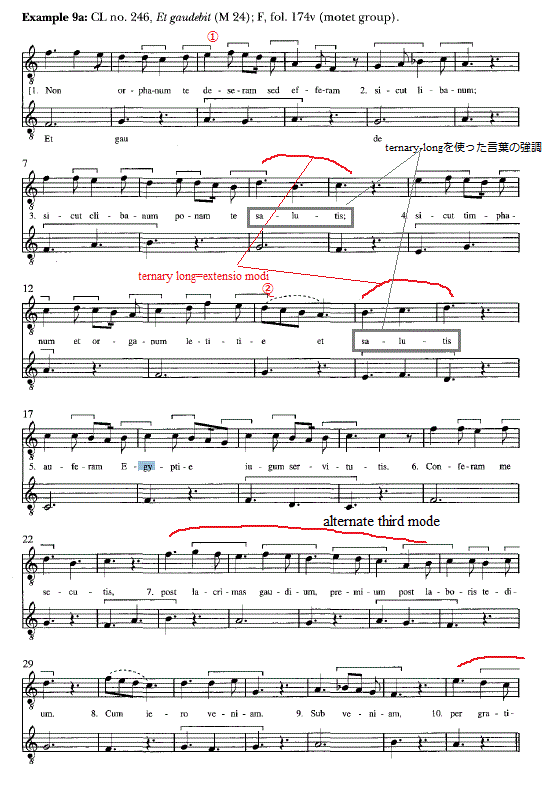 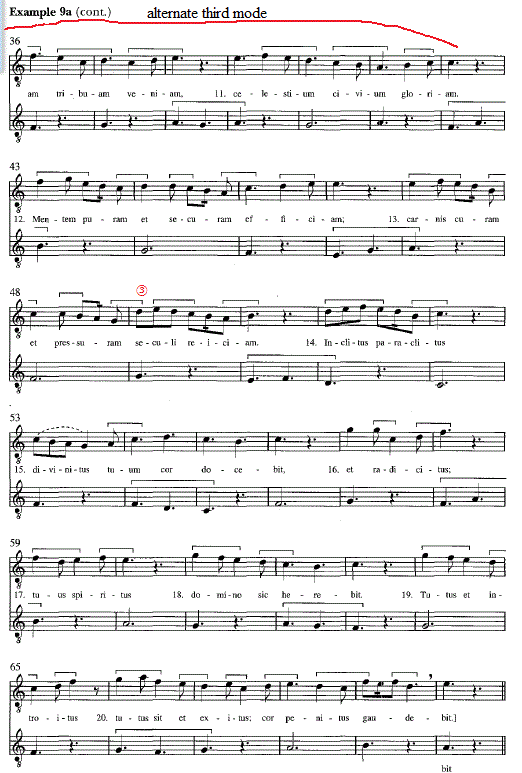 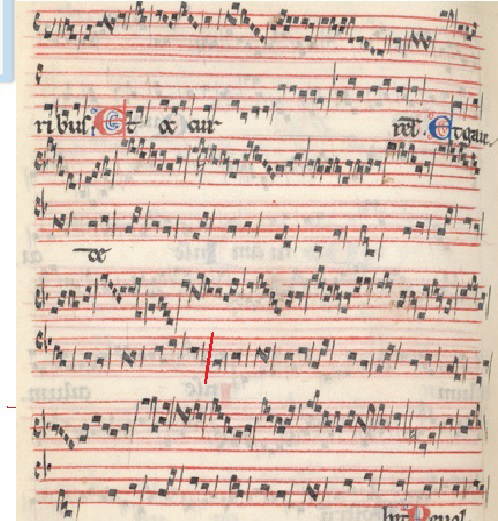 Unlike its control-group counterpart, this clausula has a modal purity level of 52.8%, which allows for varied text declamation. While some ternary-long extensions of the mode occur in short passages of alternate third mode (e.g., mm. 24-26 and 35-42), other instances of extensio modi prefigure longer passages of ternary-long declamation (e.g., mm. 9-10 and 15-16). In the texted version, the poet-composer took advantage of the change in modal patterning to emphasize the word "veniam," which is a direct quotation from the parent chant text. He then used the extended passages of ternary-long declamation to highlight the repetition of the word "salutis." Fractio modi also contributes to modal impurity in this example. However, unlike the extreme and consistent fracturing of the mode found to be atypical of motet sources, the fractio in example 9a occurs on a more localized level of one or two ternary-long beats. This type of fractio offered the motet composer a bit of flexibility with respect to text underlay. For instance, he interpreted a ternary-long beat fractured into three breves (transcribed as eighth notes) in three different ways: as two syllables in first-mode declamation (e.g., m. 3), as one syllable in extended declamation (e.g., m. 14), or as three syllables in more rapid declamation (e.g., m. 49). コントロールグループの対象と異なり、このクラウズラのモード純度は52.8%である。それは、さまざまな歌詞のデクラマシオンに適応することを意味する。いくつかのternary-longの拡大が、alternate third mode(訳注;この概念についてはEclypsim patitur参照)の短いパッセージに出現する間、他のextensio modiの例が、ternary-longのデクラマシオンの長いパッセージを予め設定する。 歌詞バージョンにおいては、作詞者は単語”veniam"(もともとのチャントからの直接の引用語)の強調のために、モデルパターンの変更を活用した。作詞者は単語”salutis"の繰り返しを目立たせるためにternary-longデクラマシオンの拡大したパッセージを利用した。Fractio modiもまた、この例におけるモード不純性に貢献している。しかしながら、モテット源としては非定型的であることがわかったモードの極端かつ一貫した破壊とは異なり、example 9aにおけるfractioは、一つまたは二つのternary-longビートのより局所的なレベルで発生する。 こうしたfractioのタイプは、モテット作曲者に歌詞づけの関する若干の柔軟性を提供する。たとえばモテット作曲者は、3つのbreveにfractureされたterunary-longビートを以下のような三通りに解釈する。①二つのシラブルを第1モードのデクラマシオンとして(e.g., m. 3) ②一つのシラブルをextendされたデクラマシオンとして(e.g., m. 14) ③三つのシラブルをよりすばやいデクラマシオンとして(e.g., m. 49) The phrasing in the clausula source for Non orphanum is irregular; its twenty phrases range from four to twelve ternary-long beats in length. The irregularities in phrasing seem even more intricate due to varied text declamation within phrases, and due to the alternation between simultaneous and overlapped phrase endings. Non orphanummに対するクラウズラ源におけるフレージングは不規則である。その4から12のternary-longビートの長さは20フレーズにも及ぶ。そのフレージングにおける不規則性は、フレーズ内の変化する歌詞のデクラマシオンに対して、そして各フレーズの終止の、同時であったりオーバーラップしたりする交代によって、より謀略的にさえ思える。 The Latin text to Non orphanum (together with a translation) appears as example 9b. As indicated, lines 3-6, and 15, 18, and 20 have final accents on the penultimate syllable, while the remaining lines have final accents on the antepenultimate syllables. The poet-composer was able to achieve such a mixture of poetic accents in part because this clausula source uses five different cadential patterns. Penultimate accents fit the feminine ending of line 5 as well as phrase endings such as line 3 that have extended declamation (marked with hyphens), while the antepenultimate accents work well with either full (indicated by asterisks), half, or implied cadences. In addition to this technical aspect of text underlay, the composer of Non orphanum seems to have drawn upon the strong closure of simultaneous phrase endings to show parallels between lines of text. For instance, the full cadences after lines 2, 3, and 4 articulate the succession of "sicut" clauses; those after lines 3 and 4 serve to reinforce the repetition of the word "salutis"; and the full cadences after lines 8 and 9 highlight the quoted text "veniam," which is also emphasized by the contrasting modal pattern. Non orphanum のラテン語歌詞はexample 9bに示される。そこでわかるように、lines 3-6, and 15, 18, and 20においては、最後のアクセントがpenultimate syllable上にある。その他の行はantepenultimate syllableに最後のアクセントを置いている。詩の作者は、パートにおける詩のアクセントをこのように混ぜ合わせることが可能だったのである。それは、このっクラウズラ源が5つの異なったカデンツパターンを持っているからである。 Penultimateアクセントは、extendされたデクラマシオンを持つ第3行のフレーズ終止同様、第5行の”feminine終止”に適合する。 antepenultimate accentが、フル、ハーフ、隠ぺいされたカデンツによく適合しているように。歌詞化におけるこうしたテクニカルな側面に対して、Non orphanumの作者は歌詞の行の間の並行性を示すために、フレーズの終わりを同時に終了するように画策しているように思える。たとえば、第2,3,4行後のフルカデンツは”sicut"の句につながるような形で明瞭になるように、第3,4行後のフルカデンツは"salutis"の語の繰り返しを強調するように、そして、第8,9行後のフルカデンツはちゃんとから引用された語句”veniam"(この語句はまた、モードパターンの対照性によって強調されてもいるが)をはっきり示せるように。 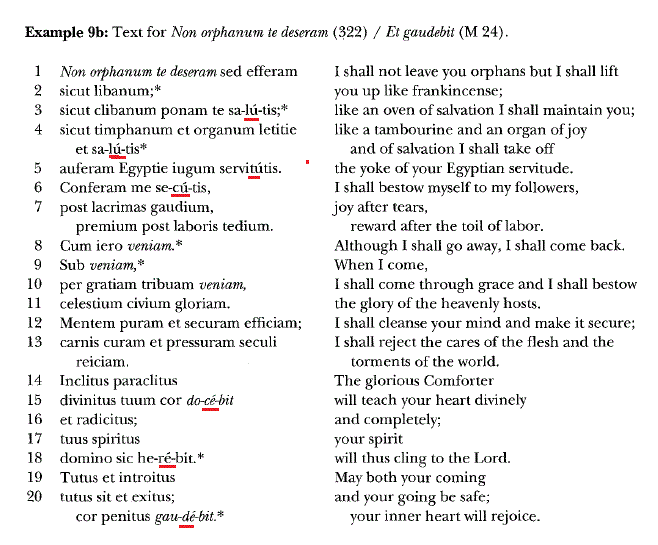 ①By comparing clausulae from the motet and control groups I have identified some stylistic features that might have attracted composers when converting clausulae into early Latin motets. It appears that the source clausulae for early Latin two-voice motets distinguish themselves from the larger repertory of Notre Dame clausulae in terms of their treatment of modal purity, phrasing, and cadential patterns. These differences suggest that for the purposes of texting, thirteenth-century composers did not view all clausulae as equal. Instead, it seems that a variety of practical and aesthetic concerns influenced their selection process. ②In general, clausulae that were too brief, were composed of very short phrases or one long phrase, had too many isolated single notes or rests, had uniform cadences, or had an excessive amount of modal fracturing rarely served as sources for early Latin motets. Apparently, these features were impractical and undesirable for texting. Nor does it appear that composers went out of their way to select clausulae that would be easy to sight read when converted into cum littera notation; very likely, the preference for internal variety in the rhythmic declamation would require prior knowledge of the clausula source's sine littera rhythmic notation. ③In addition to these practical matters, stylistic features of the motet source group point to an aesthetic preference for variety, contrast, and irregularities of design. Since these features were more pronounced in the motet sources than in the controlgroup clausulae, it appears that "irregularities" in the early Latin motet do not automatically result from texting clausulae, but instead reflect artistic choice.21 ①モテットグループとコントロールグループのクラウズラ群を比べてみて、私はクラウズラ群を初期ラテン語にconvertした時に作曲者を魅了したであろういくつかの様式的特徴を特定した。初期ラテン語2声モテット群ソースとなったクラウズラ群は、モード純度、フレージング、カデンツパターンへの扱いにおいて、ノートルダムクラウズラのたくさんのレパートリーから自らを区別しようとしていたことが明らかである。こうした相違は、歌詞化のために、13世紀の作曲者たちがあらゆるクラウズラを平等に見ることはなかった、ということを示唆している。その代り、実践的美学的関心の多様性がこうした選択過程に影響を与えたように思える。 ②一般的に、非常に短かろうが長かろうが簡単に作曲されたクラウズラは、あまりに多くの離れている単一な音符や休符を持っており、統一されたカデンツを持っており、あるいは初期ラテン語モテットのためのソースとしてはめったに役立たないようなたくさんのモードfracturを持っている(訳注;このあたりCONTRAFACTA AND TRANSCRIBED MOTETS参照のこと)。明らかに、こうした特徴は実践的ではなくかつ歌詞づけにも望ましくはなかった。作曲者たちがcum littera記譜へconvertした時に簡単に読譜できるクラウズラを外に追いやったようにも見えない。考えられることは、リズムのデクラマシオンにおける内部の多様性への嗜好が、クラウズラソースのsine litteraのリズム記譜に対する事前知識を必要としていたのであろう、ということである。 ③こうした実践的問題に加え、モテットソースグループの様式的特徴は、変化、対照性、デザインの不規則性への美学的嗜好を支持している。こうした特徴はコントロールグループのクラウズラ群よりもモテットグループのそれにより多く発表されていたので、早期ラテン語モテットにおける”不規則性”はクラウズラ群を歌詞化する上での自動的な結果ではなく、芸術的選択を反映する事柄だったのである。 |